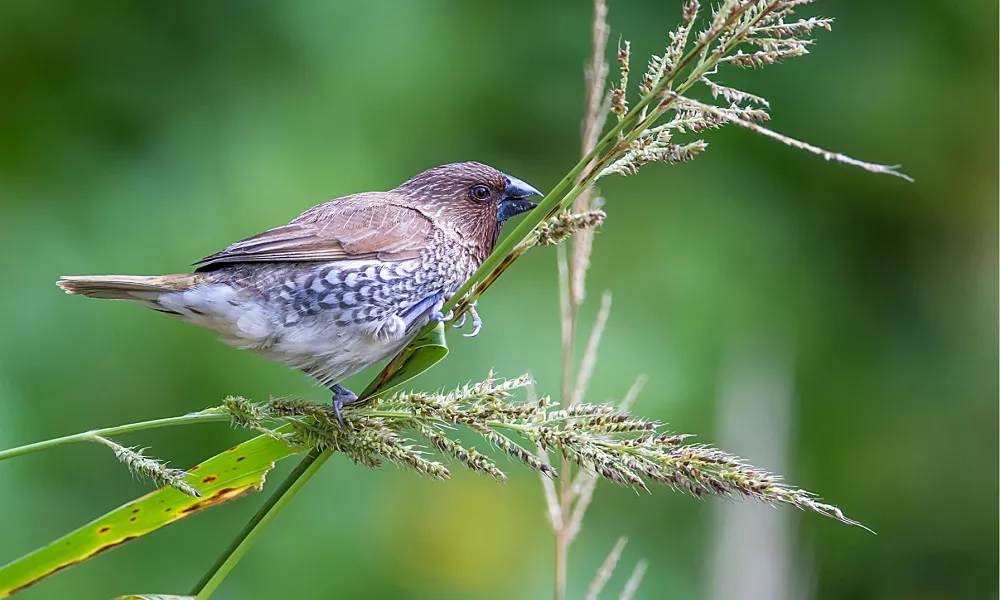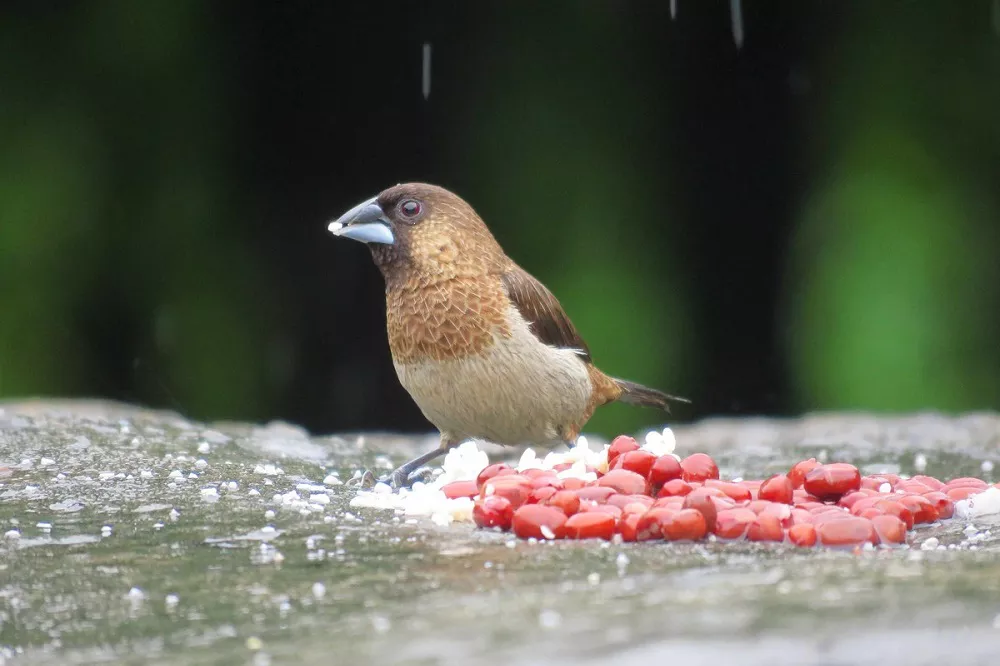The Scaly-Breasted Munia, scientifically known as Lonchura punctulata, is a small passerine bird species belonging to the family Estrildidae. It is commonly found in various parts of Asia, including South and Southeast Asia. With its distinctive appearance, behaviors, and widespread distribution, the Scaly-Breasted Munia has become a subject of interest for researchers seeking to unravel its ecological significance and contribution to biodiversity.
Physical Characteristics of The Scaly-Breasted Munia
Measuring around 10-11 cm in length, the Scaly-Breasted Munia is a petite bird with a modest yet captivating appearance. Its most distinctive feature is its scaly patterned breast, which is a mosaic of intricate black and white markings resembling scales, giving rise to its common name. The upper parts of the bird are primarily brown, while the underparts, aside from the unique breast pattern, are paler. The presence of sexual dimorphism in this species is subtle, with males and females often sharing similar appearances. However, keen observers might notice slight differences in color intensity and markings.
Scaly-Breasted Munia Range
The Scaly-Breasted Munia’s natural range spans across a vast portion of South Asia, Southeast Asia, and parts of Oceania. Its distribution extends from India, Nepal, and Bangladesh to Indonesia, Philippines, and Australia. The ability of this species to adapt to a variety of habitats has contributed to its expansive distribution. From grasslands to scrublands, agricultural fields to urban areas, the Scaly-Breasted Munia demonstrates a remarkable versatility in terms of habitat preference.
Habitat and Diet of The Scaly-Breasted Munia
This bird’s flexibility in habitat selection is attributed to its adaptable behaviors. The Scaly-Breasted Munia is known for its sociable nature, often forming flocks that can range from a few individuals to larger gatherings. These flocks exhibit coordinated movements and vocalizations, creating a harmonious display of unity. Such communal behavior not only aids in foraging and predator avoidance but also fosters a sense of camaraderie among individuals.
The Scaly-Breasted Munia’s diet is varied, consisting of a mix of seeds, grains, and small insects. Its conical beak is well-suited for extracting seeds from grasses and other plants. This dietary flexibility enables the bird to thrive in a wide range of environments, from agricultural landscapes to urban gardens.
Scaly-Breasted Munia Breeding
During the breeding season, which varies based on the geographic region, the Scaly-Breasted Munia engages in courtship rituals characterized by displays of plumage, songs, and calls. These displays serve as cues for potential mates, facilitating the formation of pair bonds. The nesting behavior of this species is fascinating; they are known to build intricate nests using grasses, leaves, and other plant materials, often weaving them into spherical structures with a side entrance. These nests are usually situated in shrubs or grasses, providing protection from predators.
Conservation Status
The Scaly-Breasted Munia is considered a species of least concern on the International Union for Conservation of Nature (IUCN) Red List. Despite habitat loss due to urbanization and agricultural expansion, this bird’s ability to adapt to human-altered landscapes has contributed to its relatively stable population. However, localized declines and population fluctuations have been observed in some regions due to factors such as illegal trapping for the pet trade and habitat degradation. Vigilance and continued research are essential to monitor the species’ status and ensure its long-term survival.
Conclusion
The Scaly-Breasted Munia stands as a testament to the avian world’s diversity and adaptability. With its distinctive scaly breast pattern, sociable behaviors, and ability to thrive in various environments, this bird captivates the imagination of bird enthusiasts and scientists alike. As we continue to explore the intricate facets of its biology, behaviors, and interactions with its surroundings, we gain a better understanding of the Scaly-Breasted Munia’s role in the grand tapestry of biodiversity. Through ongoing research, conservation efforts, and community engagement, we can ensure that this charming species continues to grace our landscapes and enrich our lives for generations to come.
FAQs About The Scaly-Breasted Munia
Q: What does the Scaly-Breasted Munia look like?
This bird is characterized by its small size, rounded body, and distinctive scalloped or scaly pattern on its breast and upperparts. It has a brownish-gray plumage with dark streaks and spots on its back and wings. The male and female birds generally have similar appearances, with males having slightly brighter colors during breeding season.
Q: Are Scaly-Breasted Munias kept as pets?
Yes, Scaly-Breasted Munias are sometimes kept as pets due to their attractive appearance and pleasant chirping. However, regulations and attitudes toward keeping wild birds as pets vary by country, and it’s important to ensure that any pet birds are obtained legally and ethically.
Q: How do Scaly-Breasted Munias reproduce?
They are known to be social birds that often form small flocks. During the breeding season, pairs of Munias engage in courtship displays, which involve singing, fluttering flights, and mutual preening. They build cup-shaped nests made of grass and other plant materials, often hidden within tall grasses. The female lays a clutch of eggs, and both parents take turns incubating the eggs and caring for the chicks.
Q: Is scaly-breasted Munia rare?
The Scaly-breasted Munia is not considered rare and is widespread throughout its range. It is adaptable to various habitats, including grasslands, rice fields, agricultural areas, and gardens. Due to its adaptability and good tolerance of human presence, it is commonly found in urban and suburban areas as well.
Q: Are scaly-breasted munias invasive?
Yes, the Scaly-breasted Munia is considered an invasive species in several places outside its native range. It has been introduced to various countries, often unintentionally but sometimes intentionally, for their attractive plumage and pleasant song. Once established in new areas, they can reproduce rapidly and outcompete native bird species for resources such as food and nesting sites.
Q: Where are scaly-breasted Munia from?
The Scaly-breasted Munia is a small bird that belongs to the estrildid finch family. Its natural range includes South Asia and Southeast Asia. Specifically, it can be found in countries like India, Sri Lanka, Bangladesh, Nepal, Bhutan, Myanmar, Thailand, Malaysia, Indonesia, the Philippines, and other neighboring areas. They inhabit a variety of habitats including grasslands, open woodlands, scrublands, agricultural areas, and urban areas.



 Facebook
Facebook  Instagram
Instagram  Youtube
Youtube 